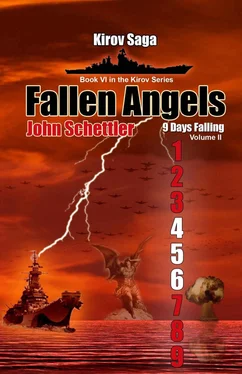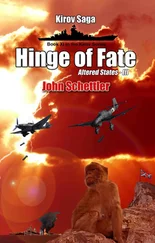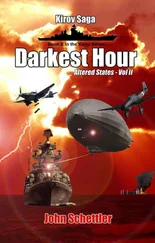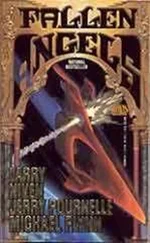Minutes later, however, they could see the evil mushroom cloud, rising ever higher in the distance from beyond the deceptively placid curve of the earth, and it put well deserved fear into the gut of every man who looked at it. Would the Captain use another if the Americans did not back down? Nikolin’s voice had just the hint of a plea in it as he broadcast in English. There was only silence in return.
“They don’t answer, sir,” he said dejectedly. “I’ve sent the message three times now.”
Karpov seemed angry. “What is wrong with them? Don’t they see what we’re capable of?”
“Perhaps the detonation affected their communications.” Rodenko was at the Captain’s side now, arms folded, considering the situation.
“Mister Nikolin?”
“Possible, but not likely, sir. They don’t have advanced electronics, and in many ways their systems would be much less vulnerable to EMP effects.”
“I agree,” said Rodenko. “That was a very low altitude airburst. There was no significant EMP burst in any case.”
“Then they are deliberately maintaining radio silence,” Karpov concluded. “Which means they could be planning something—some surprise attack.”
“They won’t be able to surprise us, sir. We have helicopters up and we’ll see any launch operation from their carriers.”
“How soon will they be reporting in?”
“Any minute now, Captain.”
Tasarov shifted uncomfortably in his chair, his brow furrowed, and obvious concentration on his face. Karpov caught the movement out of the corner of his eye, a wary look on his face. He had seen that look before, and knew that Tasarov was processing something, a hidden signal return picked up on the ship’s sonar. He waited, watching his sonar man intently until Tasarov looked in his direction.
“Con, sonar. Undersea contact, possible submarine, confidence high. I think this is a diesel electric boat, sir. Bearing 240 degrees, range approximate at 18,000 meters; speed six knots and closing on our position.”
“Someone is creeping up on us,” said Karpov looking at Rodenko. “That doesn’t sound very friendly. Do we have another KA-40 ready for launch?”
“Yes sir, the second helo is on ready alert.”
“Launch immediately. Overfly the contact and refine its position with sonobuoys. They may think they can sneak up on us like this, but we’ll soon show them otherwise.”
* * *
USS Archer-Fish was the unhappy recipient of Karpov’s attention that day. The boat had been out on its seventh and final war time patrol, assigned to provide life guard services for B-29 crews should any be lost in the last days over Japan. For Commander Joseph, Francis Enright, it was lackluster duty compared to the old glory days earlier in the year when he had stuck one of the largest feathers any submarine commander could ever earn in his cap discovering a formation of five ships, a carrier with four escorts.
After a heady race to get ahead of the Japanese flotilla and achieve firing position, Archer-Fish dealt a spread of six torpedoes from her forward tubes and, quite amazingly, scored six hits on the target. He would soon get credit for the sinking of Shinano , the world’s largest aircraft carrier at the time. Originally laid down as the third Yamato Class hull, work was stopped on the battleship and she was wisely converted to an aircraft carrier. Now Enright was slated to receive a Presidential Citation for his effort, and the kill filled the crew with pride and enthusiasm for battle.
Their next patrol had not been so glorious. Enright found himself in a small three boat wolfpack dubbed “Joes Jugheads” in the South China Sea. In one brief engagement the boat believed they hit and sank a Japanese submarine, though the kill would later be stricken as unconfirmed. Finally, on her last patrol, the war ended as the boat was cruising just off the southernmost tip of Hokkaido, Cape Erimo Saki. The jubilation on the announcement was well earned, but short-lived as well. Archer-Fish was heading for Tokyo Bay to join the planned surrender ceremony when she received orders to make an abrupt about face and head north.
There was a gaggle of loose subs around Hokkaido at the time. Two others were nearby to join the unusual operation, the Atule under Commander John Maurer and the old Gato , first boat in her class, under Lt. Commander Richard Farell. Together they had accounted for a few Japanese coastal corvettes and a sub chaser in the waters off Hokkaido as the war ended, but now they were to join Enright and the esteemed Archer-Fish in a new wolfpack heading north to look for Russians! It was a most unusual order, which had a good number of jaws wagging in the crew compartments as the boat turned north.
Enright wasn’t happy about the duty. He had been all set to lay eyes on Tokyo Bay, and now here he was, still sweltering in the boat with his fluky air conditioning. So much for the grease monkeys. They were supposed to fix the damn thing but whatever they did only made things worse. He had made a point of delicately mentioning that in his log: “The air conditioning alteration decreased rather than increased the habitability of the ship.” It wouldn’t matter much if they could make a steady surface approach, but for some reason the orders had emphasized that they were to proceed submerged, surfacing only to make scheduled radar checks, and to look for three Russian ships.
He swiped his brow with a handkerchief, looking over at Lt. Commander L.G. Bernard near the periscope. The protocol was to make periscope depth and check radar returns at thirty minute intervals. Then they would submerge deeper, alter heading, and proceed toward any contacts. They had been creeping up the east coast of Hokkaido and were now about 20 miles northeast of Shikotan Island. The long gray profiles of the southern Kuriles were evident in the distance when they surfaced.
“Still reading that interference on the APR?” Enright checked with Bernard on some unusual readings they had during the last radar sweep.
“It’s not on the same band width and pulse as any Jap radar,” said Bernard. “Suddenly stopped about five minutes ago. Now we’re getting pings. Sounds like something is up there nosing around.”
“Sonar has no screw noise close in, just that dull rumble at long range we took to be our target contact.”
“There was also that Typhoon warning. We bumped into something a couple hours ago, but there was no apparent damage. That said, the storm might be stirring things up enough to move a lot of debris our way.”
“I wouldn’t worry about the storm way up here. I heard it might delay the ceremony in Tokyo bay, which is fine by me. I wanted to be there for that—then we got this duty.”
“Well if the Japs have surrendered why are they still jamming?”
“Get a clue, Lieutenant Commander. We aren’t up here looking for Japs anymore. It’s the Russians this time out.”
“Yeah? Well that doesn’t make much sense either. That said, sonar has hold of something, sir. They just can’t read it through this interference. Suppose we get up and look for Gato . They were due for surface radar sweep about now.”
Enright looked at his watch, nodding. “Alright,” he said with a shrug. “Fire two smoke bombs and surface. Maybe the Radar will help sort this mess out.”
The boat was up in a few minutes and the radar man had three pips on his scope soon after. One was identified as the Gato on the IFF, the other two were both unknown—one airborne and coming in from the north, a second surface contact that was lost soon after it was first reported.
Enright climbed up the ladder to have a look with binoculars, but what he saw was unlike any aircraft he had ever laid eyes on. It moved slow, almost seemed to hover stationary at times, then moved again in the distance. What in god’s name was that?
Читать дальше











